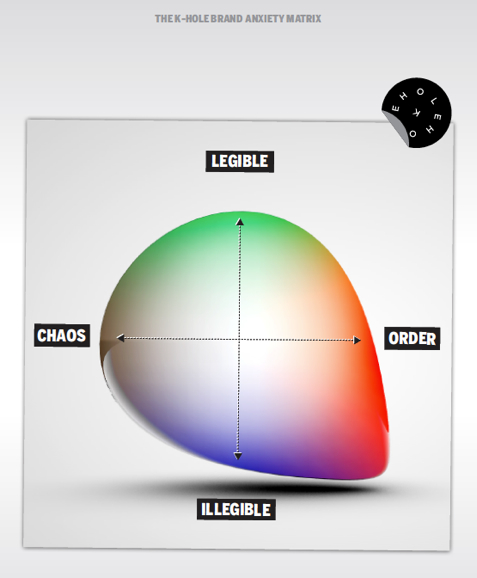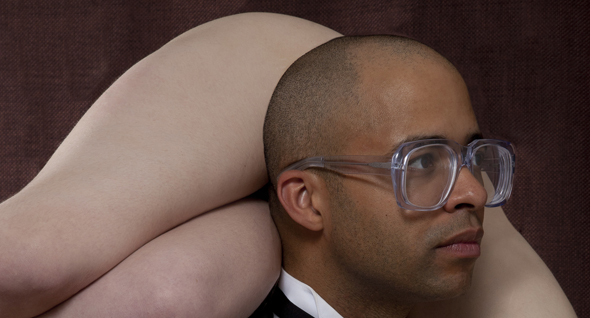As 2013 draws to a close, we've gone through the archives and assembled this selection of articles as a way of reflecting on the year in art and technology. Enjoy!

Histories of Technology
Jacob Gaboury delved into the affective, sexual dimension of computational archives in A Queer History of Computing [Part 1, 2, 3, 4, and 5]:
Thus, this is not a reinterpretation of history, or a queering of computation. Rather it is an insistence on the queer as it exists and has always existed within them.
Also:
- Lev Manovich argued for the primacy of software studies over media history.
- Tom McCormack delved into the history of the emoticon and ASCII art..
- Print designer Erich Nagler looked back on his chronic freak-outs about the rapid evolution of web design.
- Alex Duryee explained the challenges of preserving Flash-driven art.
- Megan Heuer recalled the "shimmering analog memory" of Pixelvision.
Post-Net Aesthetics
In October, Karen Archey trenchantly facilitated a panel in London that brought renewed focus to the term "postinternet" as a descriptor of recent artistic practices.
Later, Ceci Moss drew from the ideas of Terranova and Simondon to clarify the relationship between artistic practice and its technological context:
The key issue in expanded art is not that internet art is on or offline, real or virtual, net or post, but that all art is increasingly embedded within what theorist Tiziana Terranova called an "informational milieu."
Also:
- What's Postinternet Got to do with Net Art? by Michael Connor
- Post-internet Curating, Denver Style: An Interview with Carson Chan by Karen Archey
Branding and Labor

Huw Lemmey argued that the corporate language of trend forecasting was a suitable creative form for post-internet artists:
This is perhaps the key to understanding the reasons why trend forecasting has taken off within the post-internet demographic. The trend forecast represents a displaced subject: rather than being predictive or even speculative visions of what is to come, they actually function as models to conceptualise and contextualise the effects a technological explosion is having upon our everyday lives.
The strategic graphic design agency Metahaven offered up this polemic in an interview with Giampaolo Bianconi:
A brand is a socially and economically sustained form of prejudice.
In her review of Jonathan Crary's 24/7, Megan Heuer suggested that the book could have benefited from a consideration of other forms of affective labor, not only sleep:
How might we think about living through this period of capitalism such that the value of all forms of affective labor is not only understood, but preserved (or salvaged) from the assignment of a dollar value by the market?
Also:
- ATHENS, BABY: A Conversation with Poka Yio by Stephanie Bailey
- Creative 2 Professional: 7 Things to Think About by Michael Bell-Smith
- (networked) every whisper is an echo on my heart by Harry Burke
- Generation Worked by Harry Burke
- A Cavalier History of Situationism: Interview with McKenzie Wark by Brendan Byrne
- Internet Real Estate, Art and Power: The cases of Artsy and .art by Orit Gat
- AD BOOK, An Interview with BFFA3AE by Buyong Kim
Glitch Aesthetics
In a conversation with Daniel Rourke, Hito Steyerl emphasized the material existence of digital images:
Whoever is an image is an object. Whoever is not an image raise their hand. Images have permeated our environments since long time ago. They crossed screens and incarnated: as junkspace, and all sorts of 3D spam. They materialised in form of our own bodies. Images do not represent reality, they create reality, they are second nature. Things among other things, image-objects, image-events, image-situations, images-bodies.
Also:
- The Phantom Zone by Daniel Rourke
- Elsewhere, After the Flood: Glitch Feminism and the Genesis of Glitch Body Politic by Legacy Russell
- Datamoshing the Land of Ooo: An Interview with David OReilly
Performance
Jesse Darling asserted the continuing significance of the body and its labors in a high-tech world in her curator's introduction to a series of Performance GIFs series—short actions by artists, presented via the GIF format:
I wanted to stop talking about "the work" as though it exists somehow separated from our labor and from our bodies. I wanted to put the body back into the frame, since this is what we learned from OWS and Tahrir: that bodies still signify, no matter how posthuman we might imagine ourselves to be.
Also:
- Michael Connor on Tyler Coburn's Performances for Data Centers
- Rachel Rabbit White on a night of performance in Brooklyn for gURLs only.
- Adam Rothstein on The Strange Rituals of TEDx Summerisle
- Moira Weigel on Ann Hirsch's Playground.
Criticism

Orit Gat explored art criticism in the 'Age of Yelp' (by way of the online writing of critic Brian Droitcour) and saw reason for optimism:
What Yelp offers, then, is a way out of this impasse—a possibility of not just being obligated to professional colleagues, but a sense of belonging to a public.
Gene McHugh wrote a fictional account of artist Nate Hill's daily performance work:
"For spare change, I can't sing, I can't dance, but what I can do is share some art ideas I had with you today." The screech of the wheels finished his sentence with a flourish. In a mumbled rush, he announced, "Rodeo clowns, one per block, overlooking violent neighborhoods, breaking up fights with their traditional tactics. And, ah, catch a fish in the East River and run it to the Hudson before it dies."
Brian Droitcour weighed in on behalf of Michael Manning's Microsoft Store Paintings:
The image of the internet and the corporate consolidation of its parts that appears in Manning’s paintings, then, is not a neat array of self-contained silos, humming away busily as users operate inside their confines, but rather a messy mass of overlapping and colliding edifices, with the artful user at play in the openings between them.
Brendan Byrne delved into Endzone, a LiveJournal kept by the SF author Thomas M. Disch for two years before his death:
The tomsdisch of Endzone, the miniature icon with its blank humanoid face, is no more Thomas M. Disch than the authorial voice of The Waves is Virginia Woolf. We would do well to remember this when viewing the memorial Facebook pages of our loved ones or imaging the analyzation, by humans or bots, of our Twitter timelines after our own deaths.
Also:
- A Network for a Space: Auto Italia South East Moves Into King’s Cross by Stephanie Bailey
- Negative Entropy: Jan Robert Leegte’s Remake of Robert Smithson’s Spiral Jetty in Minecraft by Giampalo Bianconi
- The People Code by Brian Droitcour
- Sampling Sonic Culture: MoMA’s Cautious Entry Into a World of Noise by Sam Hart
- RIP Artists Space Cursor by Zachary Kaplan
- Questioning the World as Image: The 55th Venice Biennale and "The Whole Earth" by Ceci Moss
- Lingering Patience by Nicholas O'Brien
- Kentucky Route Zero: Adventuring into Appalachian Limbo by Nicholas O'Brien
- UBERMORGEN at Carroll/Fletcher, London by Morgan Quaintance
First Person (Artists writing about their own work):

Martine Syms outlined a set of literary rules for "Mundane Afrofuturists":
The understanding that our "twoness" is inherently contemporary, even futuristic. DuBois asks how it feels to be a problem. Ol’ Dirty Bastard says "If I got a problem, a problem's got a problem 'til it’s gone."
Also:
- Constant Dullaart wrote a techno-romantic letter to a woman who appeared in an early Photoshop meme.
- Dan Phiffer addresses the next stage of Occupy.here, his plan for autonomous, hyperlocal computer networks.
Other Features & Interviews
- (A)non-Proposition: A Conversation with Studio for Propositional Cinema by Stephanie Bailey
- Jack Goldstein, Glitch Artist? An Interview with Lorne Lanning by Michael Connor
- Sound is Here: An Interview with Barbara London by Charles Eppley
- Dear Jeff Bezos: An Interview with Johannes P Osterhoff by Ben Fino-Radin
- The Lure of an Untold Story: An Interview with Fatima Al Qadiri by Britt Julious
- MRAs and WTFs: A Context for "Nice Guys of OKCupid" by Tom McCormack
- My Life Without Technoviking: An Interview with Matthias Fritsch by Domenico Quaranta
- More Than A Feeling: An Interview with James Richards by Kari Rittenbach
- The Age of Drones by Adam Rothstein
- Growing Up Internet: The Case of Chris Poole by Zoë Salditch
Online Exhibition
- Jesse Darling (Curator), Performance GIFs
- Jonas Lund, We See in Every Direction
- Deanna Havas, Affiliate Program
- Andrew Norman Wilson, ECCOS
- Molly Crabapple, Glass Gaze
- Vince McKelvie, Rendered/Realtime
Artist Profiles
From Jeff Baij's Artist Profile by Brian Droitcour:
i get super wasted with a lot of like "cool" and "up and coming" artists on the regs and being the net guy/ coolest person in the room is like, pretty exhausting u know?
i just wanna use this space to say plz dont remove any of the swearing from the interview, ive waited a very very long time for this
Also:
- Ed Atkins
- Nick Briz
- Émilie Gervais
- Paul Kneale
- Kimmo Modig
- Alex Myers
- Sascha Pohflepp
- Rachel Reupke
- Steve Roggenbuck
- Harry Sanderson
- Erica Scourti
- Lance Wakeling
Prosthetic Knowledge Picks
An ongoing series of themed collections of creative projects assembled by Prosthetic Knowledge.
- The Year of the Oculus Rift
- Computational Photography
- Net Artist Music Videos
- The Polygon Glitch
- Dance and Technology
- Privacy Exposed To Radiant Light
- Other Worlds - Return
- Turntables and Records
- The Gaming Canvas
- Arrays and Matrices
- WebGL
- Contemporary Plotter
- Slitscan
- Surveillance Painting
- Typewriter

